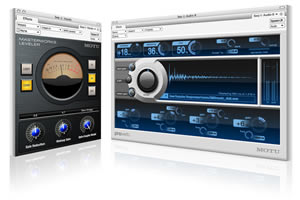
At NAMM, MOTU revealed Digital Performer 6, a major upgrade to its flagship audio sequencer software. New features include a complete user interface redesign, XML file interchange with Final Cut Pro, other film scoring enhancements, track comping, support for interleaved broadcast WAVE audio files, enhanced support for operation as a software front end for Pro Tools HD systems, pre-rendering of virtual instruments, better support for third-party Audio Unit (AU) plug-ins, the ability to "bounce and burn" directly to an audio CD and many other productivity enhancements.
User Interface Redesign
In addition to its updated "look and feel", Digital Performer 6 has been further streamlined to allow existing users to work faster and new users to learn the program quickly and easily. Highlights include:
- Vertically resizable track list: Gives users a better look at each track's settings and graphic overview.
- Streamlined window design: Windows look cleaner and information is easier to see. Zooming and navigation controls have been unified throughout. Live window resizing allows users to see the contents of the window as it is resized.
- Window tabs: Users can create as many tabs as they wish in any cell in the consolidated window, even sidebar cells.
- Inspector palettes: Important settings and information now appear in inspector palettes, which can float as independent windows or "pop into" the consolidated window as sidebar cells with tabs. New inspector palettes include Snap Info, Event Info, Cursor Info, Selection Info and others.
- Universal track selector: The unified Track Selector conserves screen space by offering one track selector that updates when you switch to a different window tab.
Track comping
DP6's new track comping features are very flexible and offer limitless comping possibilities. Previous versions of Digital Performer allowed users to record multiple takes into a track, and then choose one take in the track for playback and editing. Now users can choose "Show Takes" to view all takes side by side. Using the new Take Tool, users can easily make split points across all takes and then simply click the desired section from each take to quickly create a composite (comp) take consisting of the sections selected from each take. In the resulting comp take, crossfades can be applied, along with all standard operations for editing audio regions in a DP track. Users can then use the resulting comp track as yet another take itself, which allows users to "comp the comp" by incorporating any portion of an existing comp take into a new comp take.
The "Turn All Takes Into Tracks" and "Absorb Tracks" commands allow users to explode takes into tracks, or collapse tracks into takes, respectively — although in many respects takes behave just like tracks, with their own play/mute buttons, output assignments, automation settings and so on. Users can freely move tracks between the two models (takes and tracks), which is especially helpful for working with projects created in earlier versions where takes may have been spread across multiple tracks.
 ProVerb Convolution Reverb Plug-in
ProVerb Convolution Reverb Plug-in
ProVerb is a CPU-efficient convolution reverb plug-in for DP6 that delivers the sound of realistic acoustic spaces to any track or mix. Dozens of preset acoustic spaces (impulse responses) are included, and users can simply drag and drop any standard audio file into ProVerb's waveform display to add their own. ProVerb has been heavily optimized so that all parameters can be adjusted in real time, including those that modify the impulse response waveform itself. What might take 10-15 seconds in other convolution products occurs in real time in ProVerb, as you adjust the parameter. Users can quickly and efficiently sculpt their sound with predelay, damping, 4 bands of EQ and four modes for adjusting the wet/dry mix.
ProVerb also includes a unique Dynamic Mix feature that automatically "ducks" the wet signal as the dry input signal rises, then raises the wet mix as the dry signal level subsides. Properly tuned, this feature allows a "wetter" mix while retaining intelligibility of the input signal. Threshold, sensitivity and strength settings are provided, allowing the feature to function just like a mix engineer expertly "riding" the wet/dry mix control during playback.
MasterWorks Leveler
As the latest addition to DP's growing line of advanced audio processing plug-ins, the MasterWorks Leveler is an accurate model of the legendary Teletronix LA-2A optical leveling amplifier, known for its unique and highly sought-after Automatic Gain Control (AGC) characteristics. Conventional compression and limiting with threshold, attack, ratio, release, etc. do not apply here: the heart of the LA-2A is the T4 opto-coupler, a photoelectric device with almost magical (signal dependent) self-adjusting behavior that makes optical compressors the tool of choice for smoothing out just about any audio material, from vocals to bass guitar to full-program mixes, without destroying perceived dynamics. As a result, the MasterWorks Leveler controls match the front panel of the original LA-2A: Gain Reduction and Makeup Gain knobs, along with Limiter/Compressor buttons and an accurately modeled VU meter that adheres to IEC standards. The LA-2A evolved over the years, producing slightly different characteristics in each generation, so the MasterWorks Leveler also provides four different LA-2A models: slow/fast vintage and slow/fast modern.
XML file interchange with Final Cut Pro
Both Digital Performer and Final Cut Pro (FCP) offer complete end-to-end production workflow: Final Cut for picture and DP for complete soundtracks including music, dialog, foley and sound effects. The two most pressing challenges for any soundtrack producer are tight deadlines and last-minute picture edits. DP6 now allows for a dynamic link between the FCP editor and the soundtrack producer working in DP6. This link can be easily managed remotely via emailed XML interchange files (which are very small) or via a dynamic link between DP6 and Final Cut running side by side on the same computer.
Here's how it works. When picture edits are made in Final Cut, the FCP editor can export an XML file that describes all current edits, which the DP6 composer/editor can simply import to then compare and conform all music and audio tracks to the latest picture edits. All changes are displayed in DP6's new "Import Final Cut Pro XML" window, which provides a complete, detailed list of every new picture edit. Double-click any edit in the list, and DP6 scrolls to and highlights the location of the edit in the Sequence Editor time line. The highlight shows a blue border (old position) and red border (new position) for each picture edit. The DP6 composer/editor can then adjust their conductor track, audio data and/or MIDI data as necessary to conform to the new edit, "snapping" their edits to the vertical red line if necessary.
If DP6 is running on the same computer as Final Cut Pro, the "Export Final Cut Pro XML" command sends all tracks (and all sequences) in the current DP project to the project currently open in Final Cut Pro (or any FCP file on disk, if desired), allowing easy transfer of all work done in DP6 into Final Cut at any point during the production process, from previewing dailies to final conform and export from Final Cut.
In the pressure-cooker world of film and broadcast, soundtrack production most often happens late in the overall production cycle, and these time-saving features offer the possibility for a quantum leap forward in up-to-the-minute delivery of changes to music and sound for picture.
Other video/film scoring enhancements
DP6 now supports the following frame rates: 23.976 fps and 30-drop. DP6 can also now apply streamers, flutters, punches and all other visual cues directly to DV output (for NTSC monitoring) without the need to bounce them to a QuickTime movie beforehand.
Virtual instrument performance gains
One year ago at NAMM 2007, MOTU demonstrated Digital Performer 5 running over one thousand plug-ins on a quad-core Intel Mac tower. Similar performance gains are now possible in DP6 for virtual instrument plug-ins (DP's included MAS instruments and third-party AU instruments alike). Users can run many more sequenced virtual instrument tracks, as DP6 now pre-renders instrument track output before playback actually begins, allowing the computer's CPU to distribute the required processing beforehand, rather than in real time.
Because they are now pre-rendered, instrument tracks can now be included in Bounce to Disk operations without the need to "freeze" the instrument track beforehand. DP6's Meter Bridge now also displays instrument audio outputs.
Enhanced Audio Unit plug-in support
The Digital Performer engineering team works closely with Apple engineering on a on-going basis to continue improving Digital Performer on the Mac as an advanced platform for music and audio production. As a result, the Audio Unit (AU) plug-in specification continues to be improved with new host/plug-in API's that add new features and better performance.
DP6 includes many enhancements that are a result of this collaboration. For example, third-party AU virtual instrument plug-ins are now 100% sample accurate, providing the tightest possible timing between MIDI tracks in DP6 and their AU instrument output. DP6 also supports AU plug-in side chain inputs, Cocoa-based AU graphics and ramp-based automation for all automatable AU plug-ins. All AU plug-in parameters can be controlled with external control surfaces such as the new Euphonix MC Control and MC Mix Artist Series controllers, the Mackie Control Universal Pro and other supported worksurface devices. There is also an emerging class of AU instrument plug-in products such as the Access Virus TI and Synful Orchestra that take advantage of the AU spec's new prioritized MIDI specification, which allows DP6 to take full advantage of the features in these products.
Enhanced support for Pro Tools HD
Digital Performer continues to be a leading alternative software front-end for Pro Tools HD systems. DP6 now supports the use of RTAS plug-ins on aux tracks and master faders. In addition, DP6 supports the use of RTAS plug-ins under DAE on post-TDM inserts.
Other enhancements for DAE operation include support for multi-mono effects (to support this mode in Massenberg plug-ins for example), support for instrument side-chain outputs and support for DAE's categorized effects menu.
Other new features:
- Native support for broadcast WAVE and AIFF: DP6 now allows users to choose broadcast WAVE, AIFF or Sound Designer II (SDII) as their default audio file format. This allows users to record, play and import audio in the chosen format. Separate preferences are provided for project file formats and default file formats.
- Native support for interleaved audio files: DP6 can now record and play interleaved audio files (stereo and surround), without the need to de-interleave them into mono files beforehand.
- Support for floating point audio files: DP6 can now import, record and play floating point audio files.
- Plug-in management: This new preference helps DP users manage large numbers of installed third-party plug-ins. Users can enable/disable plug-ins, create plug-in sets, force plug-ins to load when they don't pass AU validation, re-examine plug-ins for validation and other housekeeping chores.
- Direct audio CD burning: DP6 users can master and burn their own audio CDs directly in DP by simply dropping their songs into a track, adding markers for index points anywhere they want (even in the middle of a song), creating fades and automation, applying mastering plug-in processing as desired and then choosing "Bounce to Disk". When they then choose "Audio CD" as the destination for the bounce and place a blank disc in the CD tray of their computer, DP6 creates a standard audio CD for use in any CD player. DP can also create a disk image for easy replication and archiving.
Digital Performer 6 is expected to ship in Q1, 2008, with a list price of $795. Existing registered DP users will be able to purchase an upgrade online at the MOTU web site.



 Other Related News
Other Related News

